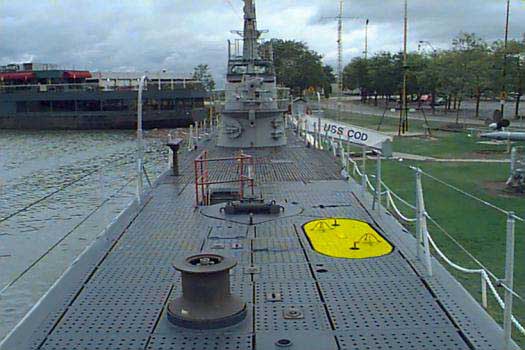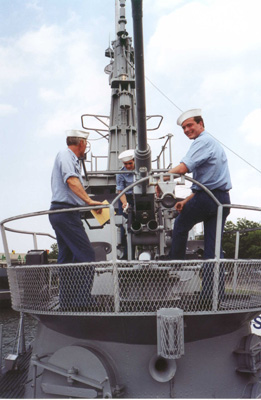
The wooden deck planking has been largely replaced and is no longer the original teakwood. Some of it had been replaced after it was damaged by depth charges and strafing from enemy aircraft during WW-II. The fairwater deck inside the conning tower and the afterbattery access hatch are both covered with original deck boards. Though teakwood is no longer easily available it is our hope that someday we will find enough to replace Cod's deck exactly as it was during her years of Naval service.
During the last part of WW-II and her Cold War commissioning Cod was armed just as in her present configuration with one 5"-25 caliber wet-mount deck gun located on the main deck just aft of the bridge, two 40 millimeter guns, one forward and one aft on the bridge, and several 50-caliber machine guns that were mounted as needed on the gun-mount posts still in place.
The round water-tight lockers around the outside of the conning tower are for the storage of shells and are called 'ready ammo lockers'. The 50-caliber machine guns were also stowed in these lockers when not in use.
The reason for all of the holes and openings in the deck and superstructure are to provide an unobstructed path for escaping air when diving, thus preventing air pockets from forming when the submarine is submerging or water pockets from forming when on the surface. The rapid flooding of Cod's vented spaces allow her to submerge very quickly. From a running start on the surface Cod could submerge to periscope depth (63 feet) in about 40 seconds!
The "T"-shaped structure just aft of the forward hatch on the Starboard side about three feet high and four feet long is the JP-1 hydrophone, part of Cod's SONAR listening gear. The JP-1 is for listening to water-borne sounds when the submarine is submerged. It can be rotated by hand (look for the blue "steering wheel" just aft of the officer's head) to locate the direction from which a particular sound is coming and can thus determine the bearing of a potential target or attacker.
Cod is also fitted with rescue buoys on the forward and after decks. These steel floats could be released by the crew if the submarine were stuck on the bottom and could not surface. (The yellow 'oval' shaped forward rescue buoy can be seen on the port side of the forward deck in the photo below.) Steel cables secure the buoys to the deck of the submarine and allow rescue vessels to communicate with the sub's crewmen. The cables also can be used to guide a rescue bell down to the submarine's forward and after torpedo room hatches where it can mate with the hatch and permit the crew to escape from the sunken submarine.
During wartime the rescue buoys are painted to match the deck, and are welded into place to prevent them from being accidently deployed and thus revealing Cod's position to an enemy.

In the photo below three crewmen are cleaning one of Cod's single barrel 40-mm guns. The "travel lock", which clamps the gun barrel in position while not in use, has been released and taken its inverted position which provides a smooth travel stop to prevent the gun from being pointed at Cod's foredeck.
